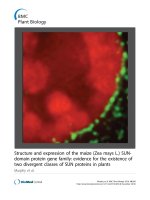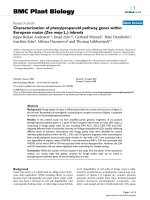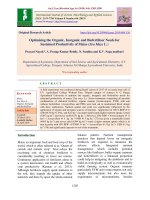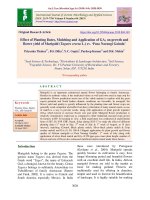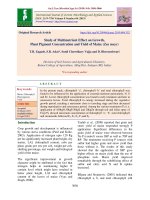Effect of potassium nitrate on yield and yield attributes of spring maize (Zea mays L.) under different dates of planting
Bạn đang xem bản rút gọn của tài liệu. Xem và tải ngay bản đầy đủ của tài liệu tại đây (227.59 KB, 10 trang )
Int.J.Curr.Microbiol.App.Sci (2017) 6(3): 1581-1590
International Journal of Current Microbiology and Applied Sciences
ISSN: 2319-7706 Volume 6 Number 3 (2017) pp. 1581-1590
Journal homepage:
Original Research Article
/>
Effect of Potassium Nitrate on Yield and Yield Attributes of
Spring Maize (Zea mays L.) under Different Dates of Planting
Harmeet Singh*, Mandeep Singh and Jasjit Singh Kang
Department of Agronomy, Punjab Agricultural University, Ludhiana-141004, India
*Corresponding author
ABSTRACT
Keywords
Spring maize, Heat
stress, Dates of
planting, Foliar
application, KNO3.
Article Info
Accepted:
22 February 2017
Available Online:
10 March 2017
A field experiment entitled was conducted on loamy sand soil, which was low in organic
carbon and available nitrogen and medium in available phosphorus and potassium during
spring season of 2014 and 2015 at Student's Research Farm, Punjab Agricultural
University, Ludhiana. Experiment was laid out in split plot design with four replications
with three dates of planting viz. February 10, February 20 and March 2 in main plots and
seven foliar applications viz. 1% KNO3 at tassel initiation, 2% KNO3 at tassel initiation,
1% KNO3 at tassel initiation+ another spray after one week, 2% KNO3 at tassel initiation+
another spray after one week, WS at tassel initiation tassel initiation+ another spray after
one week and control (no spray) in sub plots. Different planting dates as well as foliar
applications of both water and KNO3 had a significant effect on yield and yield attributes
of spring maize. The planting of maize on February 20 gave significantly higher grain
yield. Various yield attributes (number of cobs per plant, cob length, cob girth, number of
rows per cob, number of grains per row, number grains per cob and 100 grain weight)
were higher for February 20. Foliar application had significant effect on various yield
attributes like number of cobs per plant, cob length, cob girth, number of rows per cob,
number of grains per row, number grains per cob and 100 grain weight with 1% KNO 3 at
tassel initiation gave significantly higher grain yield.
Introduction
Maize (Zea mays L.) is one of the most
important cereal crops in world because of its
high yield potential. Among cereals, it
occupies third place after rice and wheat on
basis of both area and production in the
world. In India, maize was cultivated on an
area of 8.6 million hectare, production of 23.7
million tones and productivity 27.5 q/ha
(Anonymous, 2014). Maize contains 70
percent carbohydrates and 10 percent quality
proteins. India’s share in total world maize
production is about 2.26% and in year 2014.
India ranks sixth in maize production in the
world with area 9.4 million hectares and
annual production 23 million tonnes (USDA,
2014). Maize, being a C4 plant is considered
to be energy efficient and has high yield
potential which also adds towards its
importance in agriculture. The demand for
maize grains is increasing all over the world
due to their diversified usages such as food
for human beings, feed for the animals and
raw material for many industrial products.
With introduction and development of new
high yielding varieties and increased water
resources and irrigation facilities, maize is
1581
Int.J.Curr.Microbiol.App.Sci (2017) 6(3): 1581-1590
grown year around in India (Singh and Singh,
2000). Maize is largely grown in north Indian
states of Uttar Pradesh, Rajasthan, Madhya
Pradesh, Bihar, Himachal Pradesh, Jammu
and Kashmir and Punjab, which together
account for two-third, of the total area and
production of the crop. In south India,
Karnataka and Andhra Pradesh states are the
major producers of maize.
Date of sowing/planting is the basic and most
important factor, which affects the crop
growth and yield through its influence on
phonological
and
morphological
development. The crop sown under different
sets of environmental conditions, which are
likely to affect the plant growth and yield,
generally, the spring maize is sown from mid
January to mid February, but due to late
harvesting of potato and non availability of
labour in peak season, its sowing is often
delayed to end February to early March.
Sometimes due to prevailing low market
prices, farmers prefer to delay digging of
potato until they fetch high price which also
delays its sowing. Due to prevalent low
temperature during early February, there may
be delayed emergence while in the crop sown
late in March, the reproductive phase of crop
coincides with the period of high temperature
and might face stress at the anthesis causing
desiccation of pollens resulting in poor grain
filling in ears and reduced grain yield.
Preliminary experiments have shown wide
variations in yield of maize sown at different
dates during spring season.
Temperature stresses (high and low
temperature) are the major environmental
factors affecting plant growth, development
and also induce morphological, physiological
and biochemical changes in plants. Recently,
spray of osmoprotectants has been proposed
to mitigate the effect of temperature and water
stress (Yancey, 1994). The nutritional role of
potassium in tolerance and avoidance of
abiotic stress is universal. Application of
potassium nitrate (KNO3) may be considered
as an option through its effect on water
uptake, root growth, transpiration and
stomatal behavior (Nelson 1980, Hsiao and
Lauchli, 1986). Besides, crop growth can also
be enhanced through nitrogen and potassium
nutrition as N and K play a unique role in
metabolic, physiological and biochemical
functions of plants. Application of KNO3 at
different doses may also have differential
response in terms of growth and development
of a crop
Materials and Methods
The experiment was conducted at the
Student's Research Farm Punjab Agricultural
University, Ludhiana, Punjab, India during
the spring season for two years i.e. spring
2014 and 2015. The soil of experimental field
was loamy sand, which was low in organic
carbon and available nitrogen and medium in
available phosphorus and potassium The trial
was laid out in Split Plot Design (SPD) with
four replications assigning 21treatment
combinations of 3 sowing dates (February 10,
February 20 and March 2) in main plots, six
level of foliar application (water spray (WS)
at tassel initiation, WS at tassel initiation
stage + another spray after one week, 1%
potassium nitrate (KNO3) at tassel initiation,
1% KNO3 at tassel initiation + another spray
after one week, 2% KNO3 at tassel initiation
and 2% KNO3 at tassel initiation + another
spray after one week) and control (no spray)
in sub plots. Hybrid PMH-1 variety of maize
was sown according to the dates decided in
the treatment, maintaining 60 cm row-to-row
and 20 cm plant to plant distance with the
seed rate of 25 kg ha-1 at 2.5 cm depth with a
fixed dose of nitrogen (125 kg/ha) and
phosphorus (60 kg/ha). Data on various yield
parameters (number of cobs per plant, number
of rows per cob, number grains per row,
number of grains per cob, 100-grain weight,
1582
Int.J.Curr.Microbiol.App.Sci (2017) 6(3): 1581-1590
cob girth and cob length) were collected using
standard procedures. Grain and stover yield
was also recorded. Experiment as data was
analyzed in split plot (Cochran and Cox 1967)
as per standard statistical procedure using
CPCS1 software developed by the
Department of Mathematics and Statistics,
PAU, Ludhiana and adapted by Cheema and
Singh (1991). LSD test at 5% probability was
used to compare the differences among
treatments.
Results and Discussion
Effect of dates of plantings on yield and
yield attributes
Number of cobs per plant
Number of cobs per plant decreased
significantly with delay in planting. Maize
crop planted on February 20 produced 1.2
cobs per plant, which were 20% more than
March 2 planted crop (1.0) but statistically at
par with February 10 planted crop (1.2)
during both 2014 and 2015 year. This can be
attributed to favourable environmental
condition prevailing during early growth
stages in February planted crop resulting in
healthy development of all plants, leading to
higher number of cobs. Same result was
reported by Singh (2002) at Ludhiana the
number of cobs per plant of march planted
crop was significantly lesser than January
planted crop.
Cob length
The highest cob length was recorded in
February 20 planted crop which was 12.1%
and 10.6% higher than March 2 planted crop
in 2014 and 2015, respectively and
statistically at par with February 10 planted
crop. Singh (2011) at Ludhiana also made
similar observations in spring maize and
observed that January 17 planting resulted in
significantly more cob length (15.6%) than
that under February 28 planting.
Cob girth
Cob girth decreased significantly with delay
in planting from February to March.
Comparatively thicker cobs (15.8 cm, 16.6
cm) were produced in February 20 planted
crop being 6.7%, 10.7% thicker than that of
March 2 (14.8 cm, 15.0 cm) planted crop
during 2014 and 2015, respectively but it was
statistically at par with February 10 planted
crop.
This could be because of longer grain filling
period due to low temperature conditions and
better utilization of light resulting in
development of bold grains (Table 1). Singh
(2011) at Ludhiana also made similar
observations in spring maize and observed
that January 17 planting resulted in
significantly more cob girth (14.2%) than that
under February 28 planting. Singh (2002) also
reported similar findings.
Number of rows per cob
The data on number of rows per cob
presented in table 2 reveals that the number of
rows per cob were significantly higher in
February 20 planted crop which was
statistically at par with February 10 planted
crop during 2014 and 2015. Number of rows
per cob was decreased significantly when
planting was delayed from February 20 to
March 2. February 20 planted crop recorded
10.3%, 14.8% higher number of rows per cob
than March planted crop in 2014 and 2015,
respectively. This might due to the favorable
environmental
conditions
during
the
reproductive growth in February planted crop.
The percent increase in number of rows per
cob was 9.7 under 17th January planting as
compared to 28th February planting was
reported by Singh (2011).
1583
Int.J.Curr.Microbiol.App.Sci (2017) 6(3): 1581-1590
Number of grains per row
Number of grains per row is an important
yield attribute that influences the number of
grains per cob and finally affects the grain
yield. The data on number of grains per row
presented on table 2 reveals that a significant
difference in number of rows per cob under
different dates of plantings was observed.
February 20 planted crop recorded
significantly higher number of grains per row
(30.5, 31.4), which were 21.5%, and 22.2%
higher than March 2 planted crop (25.1, 25.7)
and statistically at par with February 10
planted crop (29.6, 30.4) in 2014 and 2015,
respectively. This might be due to prolonged
grain filling period due to favourable
temperature in February 20 planted crop.
Maryam et al., (2013) also observed that
maximum number of grains per ear row
(51.2) was observed for early sown crop and
minimum value of 41 grains per ear row for
later sown date.
Number of grains per cob
Number of grains per cob is an important
yield attributes that influences the grain yield.
Number of grains per cob are depends on
number of grains per row and number rows
per cob. It is the evident from data in table 2
that there was significant effect of planting
dates on number of grains per cob. February
20 planted maize crop recorded significantly
higher number of grains per cob (425.2,
440.9), which were 34% and 38.6% higher
than March 2 in 2014 and 2015, respectively.
It was statistically at par with February 10
planted crop in both years. This might be due
to prolonged grain filling period due to
favourable temperature in February 20
planted crop. Higher grain number in early
plantings could be attributed to more size of
source which was responsible for large size of
sink and produced more size of cobs in terms
of more length and girth and number of rows
per cob. Singh (2005) also reported that
significantly higher number of grains per cob
(431.3) in January 29 planted crop, which
were 11.4% higher than February 28 planted
crop. In Brazil, Rizzardi et al., (1994) studied
delay in sowing resulted in lower number of
grains per cob.
100- grain weight
Grain weight is important yield attribute
which is controlled both genetically and
environmentally. The data presented in table 2
revealed that planting dates had significant
effect on 100-grain weight which was
decreased with delay in planting. 100-grain
weight tended to decrease with delay in
planting from February 10 (26.8 g, 27.0 g)
and February 20 (27.8 g, 28.3 g) to March 2
(22.6 g, 22.8 g) in 2014 and 2015,
respectively. But both February plantings
were statistically at par with each other. This
might be because of long and thick cobs filled
with bold grains produced during early
planting dates having comparatively low
temperature prevailing conditions during the
extended grain filling period. A significant
decrease of 17.5% in test weight was reported
by Singh (2005) when planting was delayed
by 30 days from January 29.
Grain yield
The perusal of the data shown in table 3
revealed that different planting dates had a
significant influence on the grain yield of
maize hybrid PMH-1. Highest grain yield of
59.0 q ha-1 was recorded in February 20
planting which was 3.87%, 4.04% higher than
February 10 and 68.6%, 55.8% higher than
March 2 planting during 2014 and 2015,
respectively. February 10 and February 20
plantings were at par with each other in
respect of grain yield and both these dates
were significantly better than March 2.
Increased grain yield in planting February 20
1584
Int.J.Curr.Microbiol.App.Sci (2017) 6(3): 1581-1590
and February 10 could be because of
favourable effect of prevailing environmental
conditions on various yield attributes.
Significant increase in number of cobs per
plant, cob length, cob girth (Table 1), number
of grains per cob, number rows per cob,
number of grains per row and 100-grain
weight (Table 2) in the crop sown on
February 10 and February 20 contributed
towards increased total ear weight resulting in
higher grain yield in these sowing dates. All
these yield contributing attributes were
favourably influenced because of favourable
mean temperature of about 28.7 0C during the
grain filling period of early planting as
compared to later planting where it rose to
33.20C. Singh and Singh (2000) obtained
49.3% higher grain yield during early summer
(6 February) than late summer (April 25).
Singh (2011) at Ludhiana, who reported that
crop sown on 17 January had significantly
higher grain yield than late planting 28
February during spring season.
for spring planted maize. Singh (2011) also
reported a decrease in stover yield with delay
in plantings of spring maize from January 17
to February 28.
Stover yield
The cob girth increased progressively with the
foliar applications of either water or KNO3.
Plants sprayed with 1% potassium nitrate at
tassel initiation produced significantly thicker
cobs (15.9, 16.5 cm), which were 6.7, 7.1%
thicker than control (no spray), 5.3, 7.1%
thicker than WS at tassel initiation and 4.6,
6.4% thicker than WS at tassel initiation +
another spray after one week during 2014 and
2015, respectively and statistically at par with
foliar application of 1% potassium nitrate at
tassel initiation + another spray after one
week, 2% potassium nitrate at tassel initiation
and 2% potassium nitrate at tassel initiation +
another spray after one week (Table 1). This
might be due tendency of potassium and
nitrogen
in
accelerating
growth,
photosynthetic
activity
and
efficient
translocation of photosynthates.
Data shown in table 2 revealed that yield of
maize hybrid PMH-1 was significantly
influenced by different planting dates.
February 20 planted crop recorded highest dry
stover weight of 147.0, 153.2 q ha-1, which
were 1.4, 1.9% higher than February 10
(145.0, 150.2 q ha-1) and 21.5, 23.9% higher
than March 2 (121.0, 123.6 q ha-1) planted
crop during 2014 and 2015, respectively.
February 10 and February 20 plantings were
statistically at par with each other in respect
of stover yield and both these dates were
significantly better than March 2 planting.
This might be due more plant height and
higher dry biomass due to longer span of
growth from sowing to maturity in early
planting. The results are in conformity with
the results recorded by Singh (2002) who
reported 20.2 q ha-1 decreases in stover yield
with delay in planting from January to March
Foliar applications
Cob length
Among the foliar applications 1% potassium
nitrate application at tassel initiation produced
significantly longer cobs (19.4, 20.6 cm)
which were 8.4, 15.1% higher than control
(no spray), 7.8, 6.7% longer than WS at tassel
initiation and 7.2, 7.8 % longer than WS at
tassel initiation + another spray after one
week during 2014 and 2015, respectively and
statistically at par with rest of foliar
applications (Table 1). Serpa et al., (1984)
also reported that cob length was significantly
increased with application of potassium.
Cob girth
1585
Int.J.Curr.Microbiol.App.Sci (2017) 6(3): 1581-1590
Table.1 Effect of dates of planting and foliar application of KNO3 on yield attributes of spring maize
Treatments
Number of cobs
plant-1
Cob length
(cm)
Cob girth
(cm)
Number of
rows cob-1
Number of
grains row-1
2014
2015
2014
2014
2014
2015
2014
2015
2014
2015
10 February
1.2
1.2
19.1
20.4
15.7
16.2
13.6
13.7
29.6
30.4
20 February
1.2
1.3
19.5
20.9
15.8
16.6
13.9
14.0
30.5
31.4
2 March
1.0
1.0
17.4
18.9
14.8
15.0
12.6
12.2
25.1
25.7
LSD (p = 0.05)
0.1
0.1
0.8
0.7
0.5
0.7
0.6
0.6
3.0
2.8
1.0% KNO3 spray at Tassel Initiation (TI)
1.1
1.2
19.4
20.6
15.9
16.5
14.2
14.4
31.2
31.8
1.0% KNO3 spray at TI +another spray after one week
1.2
1.1
19.2
20.3
15.7
16.3
14.0
14.1
30.2
31.1
2.0% KNO3 spray at TI
1.1
1.2
19.0
20.1
15.6
16.3
13.9
14.1
30.2
30.8
2.0% KNO3 spray at TI +another spray after one week
1.2
1.2
19.0
20.2
15.7
16.2
14.1
14.2
30.3
30.9
Water spray at TI
1.1
1.0
18.0
19.3
15.1
15.4
12.1
12.3
25.3
26.6
Water spray at TI + another spray after one week,
1.2
1.2
18.1
19.1
15.2
15.5
13.0
12.9
25.9
27.6
Control (No spray)
1.1
1.2
17.9
18.8
14.9
15.4
12.2
12.3
24.6
25.5
LSD (p = 0.05)
NS
NS
0.8
0.5
0.4
0.6
0.6
0.5
2.0
1.9
Dates of planting
Foliar applications
LSD (p = 0.05) for interactions
NS
1586
Int.J.Curr.Microbiol.App.Sci (2017) 6(3): 1581-1590
Table.2 Effect of dates of planting and foliar application of KNO3 on number of grains per cob, 100-grain weight and grain and stover
yield (q ha-1) of spring maize
Treatments
No. of grains
cob-1
100-Grain
weight
Grain Yield
(q ha-1)
Stover Yield
(q ha-1)
2014
2015
2014
2015
2014
2015
2014
2015
10 February
405.0
419.8
26.8
27.0
56.8
59.3
145.0
150.2
20 February
425.2
440.9
27.8
28.3
59.0
61.7
147.0
153.2
2 March
315.9
318.1
22.6
22.8
35.0
39.6
121.0
123.6
LSD (p = 0.05)
37.0
41.2
1.6
2.1
5.1
4.4
5.4
6.4
1.0% KNO3 spray at tassel initiation (TI)
445.8
461.4
28.3
28.4
55.8
58.7
148.0
155.5
1.0% KNO3 spray at TI +another spray after one week
425.0
438.5
27.3
27.3
53.9
56.9
142.0
149.8
2.0% KNO3 spray at TI
421.7
434.8
27.0
27.6
54.1
56.8
142.0
151.1
2.0% KNO3 spray at TI +another spray after one week
428.7
439.2
28.0
27.5
53.9
56.8
143.0
152.4
Water spray at TI
307.5
320.7
23.4
23.7
46.9
48.3
123.0
124.5
Water spray at TI + another spray after one week,
339.5
356.6
24.5
24.2
49.0
50.1
127.0
126.5
Control (No spray)
300.0
308.5
21.8
21.6
44.1
44.8
120.0
122.0
LSD (p = 0.05)
27.0
27.7
1.6
1.6
2.5
2.3
13.5
11.3
Dates of planting
Foliar applications
LSD (p = 0.05) for interactions
NS
1587
Int.J.Curr.Microbiol.App.Sci (2017) 6(3): 1581-1590
Number of rows per cob
Number of rows per cob was significantly
influenced with foliar applications of both
water and KNO3. Foliar application of 1%
potassium nitrate at tassel initiation resulted
in more number of rows per cob (14.2, 14.4)
which was significantly more than control (no
spray) (12.2, 12.3), WS at tassel initiation
(12.1, 12.3) and WS at tassel initiation +
another spray after one week (13.0, 13.1)
during 2014 and 2015, respectively but
statistically at par with foliar application of
1% potassium nitrate at tassel initiation +
another spray after one week, 2% potassium
nitrate at tassel initiation and 2% potassium
nitrate at tassel initiation + another spray after
one week (Table 2). This might be due
tendency of potassium and nitrogen in
accelerating growth, photosynthetic activity
and efficient translocation of photosynthates.
Number of grains per row
Among the foliar application treatments 1%
potassium nitrate at tassel initiation stage
significantly increased the number grains per
row (31.2, 31.8), which were 26.8, 24.7%
more than control (no spray, 23.3, 19.5%
more than WS at tassel initiation and 20.4,
15.2% more than WS spray at tassel initiation
+ another spray after one week during 2014
and 2015, respectively while rest of the
applications were statistically at par with 1%
potassium nitrate application. This might be
due enhanced photosynthetic activity and
translocation of photosynthates by potassium
and nitrate.
Number grains per cob
Foliar applications also had significant effect
on the number of grains per cob. The crop
treated with 1% potassium nitrate produced
more number of grains per cob (445.8,461.5)
which statistically at par with foliar
application of 1% potassium nitrate at tassel
initiation + another spray after one week
(425.0, 438.5), 2% potassium nitrate at tassel
initiation (421.7, 434.8) and 2% potassium
nitrate at tassel initiation + another spray after
one week (428.7, 439.2) but significantly
higher than control (no spray), WS at tassel
initiation and WS at tassel initiation at tassel
initiation + another spray after one week
during 2014 and 2015, respectively. It might
be due to more size of source which was
responsible for large size of sink under foliar
applications of 1 and 2% KNO3. Shah (1984)
also observed that number of grains per cob
was significantly increased by application of
potassium.
100 – Grain weight
Among the foliar application 1% potassium
nitrate at tassel initiation stage significantly
increased 100-grain weight (28.3, 28.4 g),
which were 29.8, 31.5% more than control
(no spray), 21.0, 19.8% more than WS at
tassel initiation and 16, 17.4% more than WS
spray at tassel initiation + another spray after
one week during 2014 and 2015, respectively.
Rest of the treatments was statistically at par
with 1% potassium nitrate application. This
might be due enhanced photosynthetic
activity and translocation of photosynthates
by potassium and nitrate.
Grain yield
Grain yield is a function of yield attributes,
which were favorably influenced by foliar
applications. Different levels of potassium
nitrate foliar application (1 and 2%)
significantly influenced the grain yield. Foliar
application with 1% potassium nitrate at
tassel initiation stage resulted in significantly
higher grain yield (55.8, 58.7 q ha-1) which
was 26.5, 31.0% more than control (no spray),
18.9, 21.5% more than water spray at tassel
initiation and 13.8, 17.2% more than that
1588
Int.J.Curr.Microbiol.App.Sci (2017) 6(3): 1581-1590
obtained with water spray at tassel initiation +
another spray after one week during 2014 and
2015, respectively. But it was statistically at
par with foliar application of 1% potassium
nitrate at tassel initiation + another spray after
one week, 2% potassium nitrate at tassel
initiation and 2% potassium nitrate at tassel
initiation + another spray after one week with
application of 1% potassium nitrate at tassel
initiation.
Significantly increased cob length, cob girth,
number rows per cob, number of grains per
row, number of grains per cob and 100-grain
weight (Tables 1 and 2) might have resulted
in increased grain yield. Suwanarit and
Sestapukdee (1989) conducted a pot
experiment with six treatments viz. control
(no foliar), 1 per cent KCl, 1.4 per cent
KNO3, 1.2 per cent K2SO4, 1.8 per cent
KH2PO4 and 1.2 per cent K2HPO4 and sprays
were applied on the third day after 50 per cent
tasselling (50% of tassels, male flowers,
visible). Results showed that only the
potassium nitrate spray caused a statistically
significant increase in grain yield of 47 per
cent compared to the control. Ali et al (2004)
also reported that grain yield of spring maize
increased by potassium application.
Stover yield
Different foliar application of both water and
KNO3 at different stages had a pronounced
effect on the stover yield of maize crop.
Different levels of potassium nitrate foliar
application (1% and 2%) significantly
influenced the grain yield. Foliar application
with 1% potassium nitrate at tassel initiation
stage resulted in significantly higher stover
yield (148.0, 155.5 q ha-1) which was 23.3,
27.4% more than control (no spray), 20.3,
24.9% more than water spray at tassel
initiation and 16.5, 22.9% more than that
obtained with water spray at tassel initiation +
another spray after one week during 2014 and
2015, respectively. But, this treatment was
statistically at par with foliar application of
1% potassium nitrate at tassel initiation +
another spray after one week, 2 per cent
potassium nitrate at tassel initiation and 2%
potassium nitrate at tassel initiation + another
spray after one week with application of 1%
potassium nitrate at tassel initiation.
Significantly increased plant height and dry
biomass production and leaf area index might
have resulted in increased stover yield. Ali et
al., (2004) also reported that biological yield
of spring maize increased by potassium
application.
From the study of 2014 and 2015, it is
concluded that both date of planting and foliar
application had significant effect on yield
attributes and yield of spring maize. Planting
of spring maize at 20 February and 1% KNO3
at tassel initiation resulted higher yield
attributes and yield.
References
Ali, T., Anwar, S., Shah, W.A. and Ahmad,
B. 2004.
Response
of maize
hybrids/cultivars to various levels of
potassium and irrigation frequencies. J.
Agron., 3: 201-207.
Anonymous. 2013. Area and production of
maize
in
India
and
world.
http//www.factfish.com
Anonymous. 2015. Package of practices for
kharif
crops.
Pp.
19.
Punjab
Agricultural University, Ludhiana,
India.
Cheema, H.S. and Singh, B. 1991. Software
statistical package CPCS-1. Department
of Statistics, Punjab Agriculture
University, Ludhiana, India.
Cochran, W.C. and Cox, G.M. 1967.
Experimental Design, Asia Publishing
House, Bombay.
Hsiao, T.C. and Lauchli, A. 1986. Role of
potassium in plant water relations In
1589
Int.J.Curr.Microbiol.App.Sci (2017) 6(3): 1581-1590
Tinder, B and Lauchli, A (ed.). Adv. Pl.
Nut., 2: 281-312, Prager, New York.
Maryam, J., Darabi, F., Naseri, R., Naserirad,
H. and Bazdar, S. 2013. Effect of
Planting Date and Nitrogen Fertilizer
Application on Grain Yield and Yield
Components in Maize (SC 704). AmEuras. J. Agric. Environ. Sci., 13(7):
914-19.
Nelson, W.L. 1980. Interaction of potassium
with moisture and temperature In:
Nelson W L (ed.) Potassium in
Agriculture, pp. 109-12. Potash and
Phosphate Inst., Atlanta, USA.
Rizzardi, M.A., Witeck, D. and Deggerone, I.
1994. Grain yield and yield components
of maize cultivars at two sowing dates.
Ciencia Rural, 24(3): 477-82.
Serpa, J.E.S., de Carvalho, H.W.L. and
Siquira, L.A. 1984. Study on the
behavior of maize cultivars in semi arid
region of the state of Sergipe.
Comunicado Tecnico, UEPAE de
Aracaju 16: 7.
Shah, S.N.H. 1984. Effect of planting pattern
and fertilizer application on the growth
and yield of maize. M.Sc (Hons.)
Agriculture Thesis, Department of
Agronomy, University of Agriculture
Faisalabad, Pakistan.
Singh, S. and Singh, T.N. 2000. Response of
maize crop to early and late summer
sowing conditions. Indian J. Plant
Physiol., 5: 307-313.
Singh, Y. 2002. Influence of sowing dates,
spacing and varieties on growth and
yield of spring planted maize (Zea mays
L.). M. Sc. Thesis, Department of
Agronomy,
Punjab
Agricultural
University, Ludhiana, India.
Singh, K. 2005. Performance of spring
planted maize in relation to planting
dates, methods of sowing and nitrogen
levels, M.Sc. Thesis, Department of
Agronomy,
Punjab
Agricultural
University, Ludhiana, India.
Singh, M. 2011. Growth, yield and water
productivity of spring planted hybrid
maize (Zea mays L.) cultivars as
influenced by method and time of
planting and irrigation regimes, Ph.D.
Dissertation,
Punjab
Agricultural
University, Ludhiana, India.
Suwanarit, A. and Sestapukdee, M. 1989.
Stimulating effects of foliar K-fertilizer
applied at the appropriate stage of
development of maize: A new way to
increase yield and improve quality.
Plant and soil, 120(1): 111-124.
USDA.
2014.
a.
gov/posdonline/circulars/production.pdf
.
Waraich, E.A., Ahmad, A., Halim, A. and
Aziz, T. 2012. Alleviation of
temperature
stress
by
nutrient
management in crop plants: a review. J.
Soil Sci. Plant Nutr., 12(2): 221-244.
How to cite this article:
Harmeet Singh, Mandeep Singh and Jasjit Singh Kang. 2017. Effect of Potassium Nitrate on
Yield and Yield Attributes of Spring Maize (Zea mays L.) under Different Dates of Planting.
Int.J.Curr.Microbiol.App.Sci. 6(3): 1581-1590. doi: />
1590
